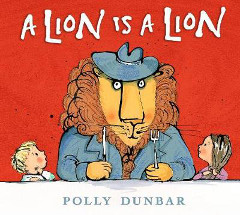A lion is a lion by Polly Dunbar

Walker Books, 2018, ISBN 978140637153
(Ages: 2-5) Recommended. Themes: Identity, Lions, Child Protection.
Polly Dunbar's fun picture book immediately starts to question the
readers' perception about the large male lion as he fiercely stares
at you. 'Fierce, isn't he? Too fierce for you?' Stop reading and ask
the audience to predict what will happen next, where will he go and
what will he do? The following pages are humorous. With questioning
text, the author paints funny scenarios as the lion dresses up in a
trilby hat, matching blue jacket and dances down the street twirling
a red umbrella. His antics are watched by a young brother and sister
safe behind the window pane.
Ding dong and the door is opened to welcome the large polite lion
who even asks about Auntie Sue's health. There's 'hoobie-doobie'
dancing and twirling to music from a wind-up gramophone, and a
delicious lunch where the plate is also eaten! A little frisson of
danger occurs as he opens his mouth wide, showing all his
pearly-white teeth, will the children become dessert? With a giant
roar, the youngsters quickly hide under the table cloth and make
their decision. Boldly they declare hand in hand, strong assertions
that it is time for the huge lion to leave with his hat and his
umbrella.
Dunbar's easy to read story includes changes of text size,
interesting word placements, and emphatic statements, and she uses a
questioning style in the narrative. Her ink-and-wash artwork is
spirited, and included are large two-page spreads where the action
is focussed on the large lion set against white space, then moves to
bright scenes filled with movement. The high-contrast red
backgrounds underpin capture the change in mood.
A Lion is a Lion carries the keep safe message, highlighting
the rights of the child to say no to intimidating behaviour. A
perfect picture book to share as a family and in a learning
environment as part of the Child Protective Behaviours curriculum
and as an introduction in English to punctuation and questioning in
dialogue.
Rhyllis Bignell